► Skoda Superb Estate long-term review
► In top-spec L&K trim, 276bhp engine
► Read our full six-month test diary here
Month 6 running a Skoda Superb 280 Estate: the conclusion to our long-term test
The two internationally recognised tests of whether a long-term test car can be said to have succeeded are as follows.
1) Would you consider buying one with your own money?
2) Would you recommend it to members of your family?
Every country on Earth signed up to these protocols, except North Korea, where it’s illegal to own a car and anyway the notion of family is a capitalist conspiracy, and Trump’s America, where it is now illegal to buy any car not made in Detroit by men called Chuck.
As we come to the end of half a year in the company of Skoda’s gargantuan flagship, let’s deal with the first one first:
I wouldn’t consider buying this car with my own money. Not because it’s unlikeable, but because in this spec it costs £40,700, and for that I could have a BMW 528i M Sport Touring, enabling me to buy slightly fewer Ikea bookcases but to execute balletic tailslides at every roundabout on the way home from that Swedish meatball and furniture emporium. Enabling me also to be considered more successful by my neighbours and to make more money at re-sale time.
From Skoda UK’s Milton Keynes HQ I can hear the sound of harrumphing, as cheesed-off executives mutter about my over-speccing of the car. They warned me against this. They may have a point. Did we really need 10 speakers, chocolate-coloured leather stitched with the name of the company’s founders (Laurin and Klement), a heated windscreen, a telly? A virtual pedal, allowing us to practise ballet while opening the boot hands-free? A keyless entry/automatic start system? Did we?
I hang my head. In fact, it wasn’t any of this frippery which made me truly smile during my time with the Superb, it was the simple, inexpensive yet fiercely clever ideas they sprinkle around the car. An ice-scraper built into the inside of the fuel filler cap, a rechargeable magnetic torch in the boot with a 48-hour charge, and my favourite, an umbrella stowed in each of the front door cavities (although not in base spec). All of these items saved my life (okay, saved me from first-world tantrums) on several occasions in a way that the endlessly changeable ambient lighting colour choice did not.
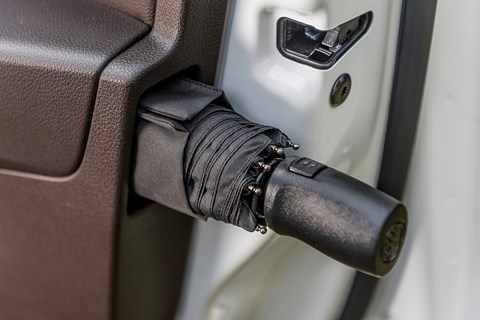
But the main reason I wouldn’t consider buying a new Superb estate L&K 2.0 TSI is that it will be the secondhand bargain of the century, shedding half its value in three years, and I wouldn’t want to miss out on what would be the biggest result since David knocked Goliath out of the Old Testament Cup. You see, the Superb is a truly gifted car. Its VW-derived MQB chassis is lightweight and agile, and from that base they’ve drawn a class-defining length of wheelbase which makes the rear cabin implausibly roomy. The turbocharged 2.0-litre petrol engine is lighter, more powerful and more efficient than the V6 FSI it replaced, and offers a proper punch (albeit while returning fuel figures that, if they were blood pressure, might scramble a crash team).
For the driver there’s much to commend, not least the steering, which is a beautiful thing, and the six-speed DSG transmission which has a Mel and Sue-style chemistry with the four-wheel-drive chassis. But let’s be fair, it’s no BMW, not even a Mercedes. It understeers enthusiastically when rinsed.
As a used purchase, though, it’s a car that makes you feel like you’ve got away with something, like you’ve found a £50 note on the floor and nobody saw you pick it up. It’s a secret, this Skoda, and you’re in on it. But if you must have a new one, go further down the range – a nice 2.0-litre TDI with 148bhp nails the value target and undoes the damage my heavy-handed box-ticking has wrought.
And as for the second test – would I recommend it to members of my family? Certainly. If only they didn’t all live in Pyongyang.
By Greg Fountain
Final logbook: Skoda Superb L&K 2.0 TSI 280PS 4x4
Engine 1984cc 16v 4-cyl, 276bhp @ 5600-6500rpm, 258lb ft @ 1700-5600rpm
Gearbox 6-speed DSG, all-wheel drive
Stats 5.8sec 0-62mph, 155mph, 164g/km CO2
Price £36,365 As tested £40,700
Miles this month 2082 Total miles 6977
Our mpg 31.1 Official mpg 39.2
Fuel cost £367.58 (Total overall fuel cost £1243.32)
Extra costs £0
Count the cost
Cost new £40,700 (including £4335 of options)
Dealer sale price £29,914
Private sale price £28,384
Part-exchange price £27,104
Cost per mile 18p
Cost per mile including depreciation £6.01
Month 5 running a Skoda Superb Estate 280: tear up the VW Group rulebook
Lack of context usually stands between a car owner and reasoned judgement. That’s nobody’s fault. If you’ve bought a car, run it for a few years and liked it, why would you want to look elsewhere for its replacement? And even if you happen to be savvier than James Corden’s agent and more thorough than HMRC, who’s got the time to test drive a dozen rivals? Which is where we come in.
But where to start? In the lavish spec we somehow alighted upon our Superb estate is a £40k car, and similar money propels you headlong into a room containing a smug-looking Audi A6 2.0 TDI Quattro S line, an ageing but suave BMW 528i M Sport Touring, and a dazzlingly new Merc E-class 200d AMG Line. If Jaguar could get its ducks in a straight enough row there’d be an XF wagon in there too. A heady bracket, albeit each of these models subjects you to the full Dick Turpin.
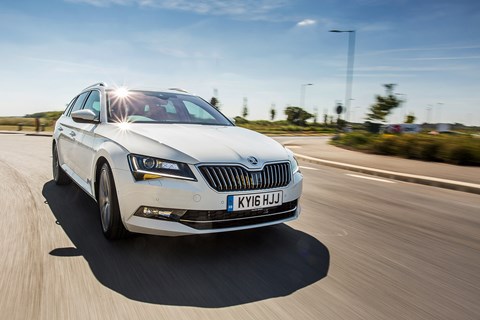
I’m not sure Skoda ever envisaged or intended mixing in these circles. The brand may have undergone a Jesus-rivalling reincarnation, but the trick unravels like a ball of string snagged on a space rocket the moment it ceases to be great value. Given that the Superb is a genuinely awesome bit of kit, however, the answer surely lies further down the range. Maybe it’s the 1.6 TDI.
Now, fastidious readers will recall that this 118bhp model was the car I first reviewed when the Superb made its debut in CAR during the autumn of 2015. I was bowled over by the car’s packaging, its looks, its quality… and its price (which today is £17,000 less than my car, that difference alone being enough to buy you an entry-level Superb 1.4 TSI hatch). On the road the 1.6 TDI costs £23,585, and suddenly the Skoda brand is back in the game.
Suddenly the room is filled with nylon-suited Vauxhall Insignia Sports Tourers, mousey Mazda 6s and grey-flannel Toyota Avensises (Avensii?). And in this company the snappy, cool-looking Superb rises like dough in a proving drawer, and achieves Skoda’s full height.
History can’t be rewritten, of course – having previously bemoaned the lack of urge served up by the 1.6 diesel engine and yearned for, at the very least, the extra 30bhp of the 2.0-litre TDI, I remain of the opinion this big car needs a gutsy heart. It also needs my car’s creamy DSG gearbox rather than the notchy manual fitted to the 1.6 TDI, even though the latter smooths off the otherwise recalcitrant stop/start system. But if the Superb’s power delivery and mid-range torque are compromised the further you tumble down the model ladder, its dynamic integrity is undimmed. So, the Skoda out-corners the Vauxhall, outrides the Toyota and gives as good as it gets in the face of the (also surprisingly tidy) Mazda. And more extraordinarily, it rides with greater compliance than the Audi A6 (though some say it’s floaty), and although the rear-driven panache of both BMW and Mercedes rather outdance it, the Skoda’s endlessly tweakable chassis gets a Len Goodman-spec ‘sev-en!’.
Or take the Superb’s cousin, the very capable VW Passat. The Skoda is the more desirable car – to look at, to drive and naturally to pay for. The question for VW Group is this: how did that happen?
By Greg Fountain
Logbook: Skoda Superb L&K 2.0 TSI 280PS 4x4
Engine 1984cc 16v turbo 4-cyl, 276bhp @ 5600-6500rpm, 258lb ft @ 1700-5600rpm
Gearbox 6-spd DSG, awd
Stats 5.8sec 0-62mph, 155mph, 164g/km CO2
Price £36,365
As tested £40,700
Miles this month 679
Total miles 4895
Our mpg 30.8
Official mpg 39.2
Fuel cost £109.36
Extra costs £0
Month 4 running a Skoda Superb Estate 280: it's something of a paradox
Harry Hill once said ‘you can tell a lot about someone by what they’re like’. The same should be true of cars. Most models fit a profile: reliable, fast, useful etc. You don’t have to be Freud to diagnose their personality.
But the Superb is tough to read. It’s a Skoda, so it’s a bargain, right? No, it’s £40k. But it’s cheap to run? No, it’s burning unleaded at an alarming 30mpg. It’s a Skoda, so it’s dull and sensible? No, it looks and feels special.
It is a paradox, paging Dr Freud…
By Greg Fountain
Logbook: Skoda Superb L&K 2.0 TSI 280PS 4x4
Engine 1984cc 16v turbo 4-cyl, 276bhp @ 5600-6500rpm, 258lb ft @ 1700-5600rpm
Gearbox 6-spd DSG, awd
Stats 5.8sec 0-62mph, 155mph, 164g/km CO2
Price £36,365
As tested £40,700
Miles this month 520
Total miles 4216
Our mpg 30.2
Official mpg 39.2
Fuel cost £145.47
Extra costs £0
Month 3 living with a Skoda Superb Estate: eats a McLaren for breakfast
The box was so big we initially thought Tim Pollard had got himself couriered back to the office so he could carry on working during the journey. Once manhandled up the stairs, slightly in the manner of a silent Eric Sykes film, the box sat by Tim’s desk, interfering with the light and compromising the fire exit. Whatever it was, no way was he ever going to get it home.
Then, inevitably: ‘Greg, can I borrow your Superb tonight?’ Tim had materialised, and not from inside the box. ‘I’ve got to get this McLaren home.’ It wasn’t a baby buggy (not a Maclaren, then), but a 1:3.5-scale ride-on electric P1 (we’ve learned not to ask about the items Tim periodically transports). ‘I’m road-testing it,’ he claimed. Of course he is.
[He was, actually: read the full Ride On McLaren P1 review here - Ed]
The McLaren is 1295mm long – slightly longer in its box. That’s about a third of the Superb’s entire 4856mm length, and not far off half of its 2841mm wheelbase. But of course it fitted. The Superb is the biggest estate car on the market, and if it can’t live with a supercar for performance, it can certainly swallow one whole.
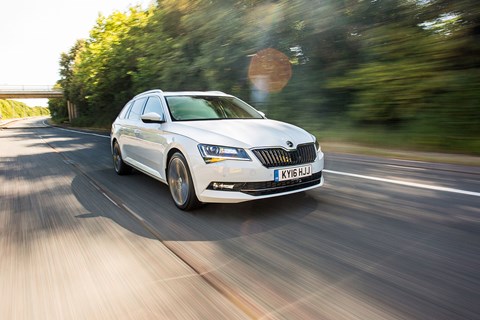
Implausible freight capacity may be the ticket on which the Superb was elected, but it’s a pony with other tricks. For a start, it’s great fun to drive, and finding out that your lengthy, weighty ship is also a sharp handler is like finding out that fine wine also makes you live longer. The engine helps – we have the most powerful of the range’s five petrol engines, the 2.0-litre TSI, and with almost equal amounts of torque (258lb ft) and power (276bhp) its delivery is balanced like a Libran wire act. There’s rarely a moment when you’re not in the meat of one or other of the rpm curves, the power reaching its peak at the exact point (5600rpm) where the torque runs out of ideas. Seamless.
It’s not a perfect confection, of course. It feels frankly odd getting frisky in something which could – and occasionally does – also contain everyone you know and everything those people own. Any squabbling occurring in the back seat, however, is nothing to the badinage going on between the sluggish throttle, the bossy DSG gearbox, the ‘why am I here?’ four-wheel-drive chassis and the steering. Why no adjective for the steering? Because it’s the best part of the controls interface – weighted like a Ping driver.
None of the above amounts to a case for the prosecution – the neutrality of the driving experience is suitable for the ‘Geoffs’ who, according to Jeremy Clarkson in the Sunday Times, drive Skodas (‘I’ve met a lot of Skoda drivers over the years. They are called Geoff, and life hasn’t been kind to any of them,’ wrote JC). And in any case, Geoff probably won’t turn to Dynamic Chassis Control, which offers five driving modes altering not just gearbox mapping, steering weight and throttle response but also tweaking the running gear, shock absorbers and all. In Individual mode, it’s my car to set up. Not Geoff’s, not Clarkson’s, not Tim Pollard’s – mine. Great. But so far I still haven’t got it quite right.
By Greg Fountain
Month 2 with a Skoda Superb Estate: initial impressions
Space, it transpires, is not only found behind Sunderland’s back four. The back seat of the Superb estate is cavernous. The Beatles surely played here. My problem is staying in the front, while all the best bits are behind me (the luggage space has its own postcode).
Luckily, there’s plenty to do stoking the pleasant 2.0-litre petrol engine and cajoling the nicely judged steering. It’s fleet-footed, this Skoda, and feels like a smaller car. And as I have only 90 words to play with, I promise not to mention the twin umbrellas. Damn.
Logbook: Skoda Superb L&K 2.0 TSI 280PS 4x4
Engine 1984cc 4-cyl, 276bhp @ 5600-6500rpm, 258lb ft @ 1700-5600rpm
Gearbox 6-speed DSG, 4wd
Stats 5.8sec 0-62mph, 155mph, 164g/km CO2
Price £36,365
As tested £40,700
Miles this month 1008
Total 2967
Our mpg 33.8
Official mpg 39.2
Fuel £117.42
Extra costs £0
By Greg Fountain
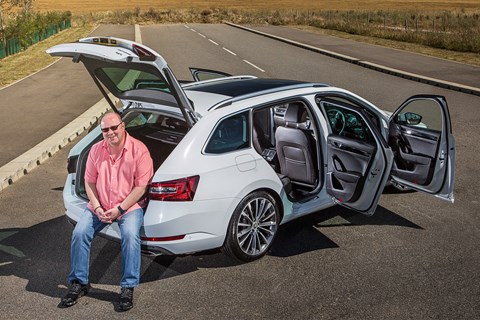
Month 1 with a Skoda Superb Estate: the introduction
They were both far-sighted guys, but surely neither Vaclav Klement nor Vaclav Laurin would have predicted, when opening their bicycle business in the Czech city of Mlada Boleslav in 1895, that their names would adorn our long-term Superb 121 years later. Klement was a bookseller and Laurin a locksmith, but the business they founded became the auto arm of a machine manufacturer called Skoda. You kind of know the rest.
In honour of these beardy, black-and-white pioneers today’s Skoda has called the top-spec Superb the Laurin & Klement edition, and thanks to badges on the front wings, kickplates, seatbacks and glovebox I’ll be dreaming about reliable Czechoslovakian bicycles for months to come.
There is scope for dissent over whether or not we used the configurator wisely when speccing this car. So much so, in fact, that I might swear in court that I never would have chosen the colour white (even if it is called ‘moon white metallic’), never would have gone for brown leather, never would have chosen petrol over diesel. The facts and the paperwork, however, demur.
Still. Early signs are that the engine – the 2.0-litre TSI with a fruity 276bhp – was in fact a good call. In testing the 1.6 diesel at launch last autumn I felt a bit under-torqued and pined for the stickier 2.0-litre, but neither unit has quite the surge of this four-pot petrol. It feels better suited to getting what is a big car (albeit modestly weighing 1635kg) down the road with a fluency befitting its status.
It’s not explosive off the line, partly due to a slightly dull throttle response and not helped by stop/start which stops better than it starts, but once up and running it’s all you could want. The six-speed DSG ’box is to blame for the stop/start time delay – in manual cars it’s seamless – but it’s a fair pay-off because the DSG has much to commend it, and seems to suit the car better.
The Superb estate joins the fleet this month because it is a superb estate. It would be a nice world if all cars wore a boot badge which is basically a condensed road-test verdict like this. A Focus RS would be badged ‘epic hot hatch’, an Allegro ‘grim sh*tbox’ etc. The Skoda has arrived at a party at which its wealthier brother, Anthony ffrench-Constant’s VW Passat estate, is already holding court at the bar, so this will be a nice tussle.
Anthony’s car contains the 2.0-litre twin-turbodiesel with less power but heaps more torque than my car, and his DSG ’box has a seventh cog. But, of course, there’s the price thing. I’m specced up to the eyeballs yet still coming in £3k cheaper than the VW.
Also – clinchingly, I think – Skoda’s miracle of packaging has 170 litres more luggage space than the Passat. Think about that. An extra 170 cartons of Tropicana orange juice! From the same platform? Admittedly the Skoda is 89mm longer than the VW, and finds an extra 50mm in the wheelbase (making the rear cabin space genuinely astonishing). But to my eye it also looks sleeker – not in any way resembling the van its capacity may suggest.
VW’s other problem is the L&K’s lavish standard equipment. We have touchscreen sat-nav with integrated WiFi, a sizzling 12-speaker Canton sound system, electric heated seats, tri-zone climate and even three-colour ambient LED lighting.
On top of that we’ve forked out £600 for WLAN with integrated internet, and ‘phonebox’, which boosts your signal by 20% and charges your phone at the same time. We’ve also got ourselves a panoramic sunroof – a trifle extravagant at £1150 but it brightens the room like the arrival of the Duchess of Cambridge.
There’s more joy to be had below decks, where the Superb gets VW’s Dynamic Chassis Control, with five driving modes (Normal, Sport, Comfort, Eco and Individual), emergency brake function, adaptive cruise control, blind-spot detection, lane assist, park assist and ‘open the boot with your hands full’ assist (aka ‘virtual pedal’).
Finally, there are the umbrellas. Two of them, neatly deployed in cubbies hidden inside the front door shells. Nobody can touch this, except Rolls-Royce. Stand by for our Superb vs Phantom twin test.
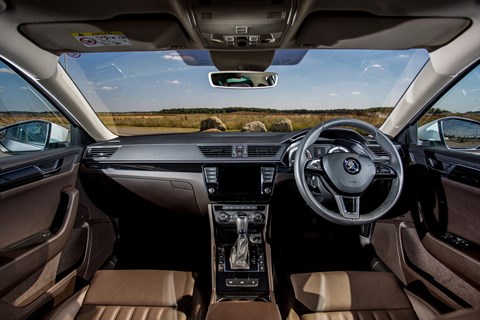
How we specified our Skoda Superb estate
- Online £600 buys us Premium WLAN with Phonebox – so we can talk, surf, charge… anything but simply drive
- Roof Panoramic sunroof was, at £1150, our biggest outlay in a total options spend of £4335. With a car this long you also need the £300 rear parking camera
- Wheels The L&K comes with 18in Pegasus anthracite alloys as standard but we swapped mythical beasts and paid £650 for 19in Phoenix items
- Bits… Ventilated front seats (£425), temporary steel spare wheel (£100), variable boot floor (£150), heated windscreen washer nozzles (£50)
- … pieces Front passenger seat adjustment from rear (£75)(like a real limo!), retractable parcel shelf (£120), traffic sign recognition (£85)
Logbook: Skoda Superb Estate L&K 2.0 TSI 280PS 4x4
Engine 1984cc 16v 4-cyl, 276bhp @ 5600-6500rpm, 258lb ft @ 1700-5600rpm
Transmission 6-spd DSG, all-wheel drive
Stats 5.8sec 0-62mph, 155mph, 164g/km CO2
Price £36,365
As tested £40,700
Miles this month 1547
Total 1959
Our mpg 33.9
Official mpg 39.2
Fuel £284.18
Extra costs £0
By Greg Fountain
Read more CAR magazine long-term tests